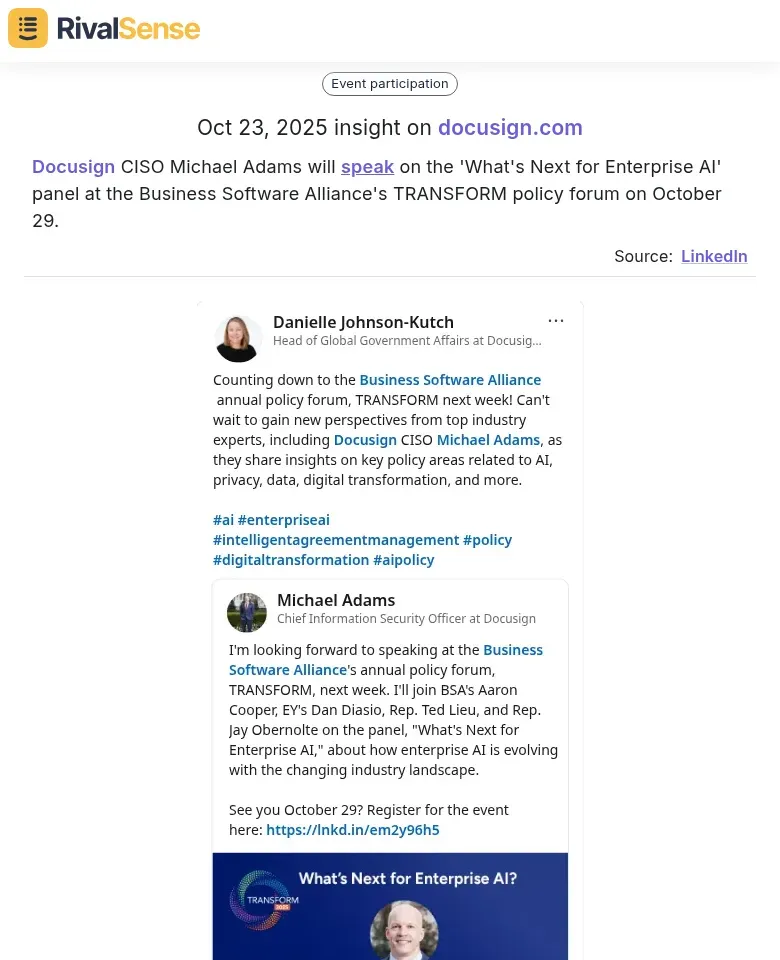Mastering Competitor Analysis with Actionable Insights
Competitor analysis is a vital practice for any business aiming to stay ahead in the market. It involves systematically tracking rivals' activities to uncover strategic shifts and emerging opportunities. By understanding what your competitors are doing, you can anticipate market changes and refine your own strategies effectively.
Real-world examples bring competitor analysis to life and show its practical value. For instance, RivalSense recently provided an insight that Docusign's CISO, Michael Adams, will speak on the 'What's Next for Enterprise AI' panel at the Business Software Alliance's TRANSFORM policy forum on October 29. This kind of information highlights a competitor's focus areas and can signal their investment in new technologies like AI.

Interpreting such insights helps you gauge potential threats or openings in your industry. When a key competitor engages in high-profile events on trending topics like AI, it may indicate a strategic pivot or innovation push that you need to monitor closely.
To build a robust competitor monitoring system, start by identifying the most relevant sources of information. Consistent tracking across websites, social media, and industry events ensures you don't miss critical updates. Here are some actionable tips to enhance your approach:
- Set Up Alerts: Use tools to get notified about competitors' news, such as product launches or executive speeches.
- Analyze Frequency: Note how often competitors participate in events or release updates—it can reveal their aggression or caution in the market.
- Engage in Social Listening: Monitor hashtags and mentions related to your rivals to catch informal insights and customer sentiments.
A structured checklist can keep your competitor analysis on track and organized. Use this to ensure you cover all bases regularly:
- [ ] Define your top 3-5 competitors and their key executives
- [ ] Schedule weekly reviews of their public activities (e.g., events, partnerships)
- [ ] Document insights in a shared dashboard for team alignment
- [ ] Assess how each finding could impact your business goals
Acting on competitor insights transforms data into strategic advantages. For example, if you learn a rival is emphasizing AI, you might accelerate your own AI projects or seek partnerships to counter their moves. Proactive responses like these can help you maintain a competitive edge and adapt quickly.
| Insight Type | Recommended Action |
|---|---|
| Event Participation | Evaluate if it aligns with new market trends and adjust your messaging |
| Product Update | Compare features and identify gaps to innovate or differentiate |
| Media Mention | Gauge public perception and craft responses if needed |
Staying updated with competitor moves doesn't have to be overwhelming with the right tools. RivalSense simplifies this by tracking company activities like product launches, pricing changes, event participations, and more, delivering consolidated reports via email. Try RivalSense for free at https://rivalsense.co/ and get your first report today to start leveraging these insights immediately!
📚 Read more
👉 How to Analyze Competitor Ads: A Practical Guide for B2B Leaders
👉 Data-Driven Key Account Identification in Pharmaceutical Logistics
👉 How Topstep's Plus500 Partnership Revealed Competitive Edge
👉 Competitor Website Change Framework for Key Account Growth
👉 Automate Key Account Tracking to Beat Ventilation System Competitors
